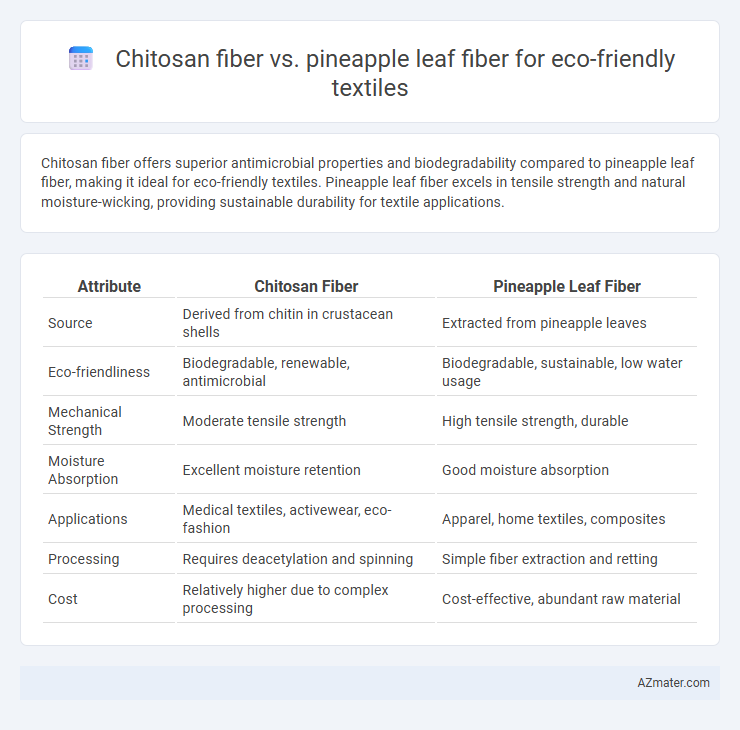Chitosan fiber offers superior antimicrobial properties and biodegradability compared to pineapple leaf fiber, making it ideal for eco-friendly textiles. Pineapple leaf fiber excels in tensile strength and natural moisture-wicking, providing sustainable durability for textile applications.
Table of Comparison
| Attribute | Chitosan Fiber | Pineapple Leaf Fiber |
|---|---|---|
| Source | Derived from chitin in crustacean shells | Extracted from pineapple leaves |
| Eco-friendliness | Biodegradable, renewable, antimicrobial | Biodegradable, sustainable, low water usage |
| Mechanical Strength | Moderate tensile strength | High tensile strength, durable |
| Moisture Absorption | Excellent moisture retention | Good moisture absorption |
| Applications | Medical textiles, activewear, eco-fashion | Apparel, home textiles, composites |
| Processing | Requires deacetylation and spinning | Simple fiber extraction and retting |
| Cost | Relatively higher due to complex processing | Cost-effective, abundant raw material |
Introduction to Eco-Friendly Textile Fibers
Chitosan fiber and pineapple leaf fiber are innovative eco-friendly textile materials gaining attention for sustainability and biodegradability. Chitosan fiber, derived from chitin found in crustacean shells, offers antimicrobial properties and biodegradability, making it ideal for medical and hygiene textiles. Pineapple leaf fiber, extracted from agricultural waste, is rich in cellulose, strong, and biodegradable, offering a renewable alternative to synthetic fibers in sustainable fashion and home textiles.
Overview of Chitosan Fiber
Chitosan fiber, derived from chitin found in crustacean shells, offers exceptional biodegradability and antimicrobial properties, making it a highly sustainable choice for eco-friendly textiles. Its ability to enhance moisture absorption and promote skin health positions it as a superior alternative to plant-based fibers like pineapple leaf fiber. The production process of chitosan fiber also utilizes renewable bio-waste, significantly reducing the environmental footprint compared to conventional textile fibers.
Overview of Pineapple Leaf Fiber
Pineapple leaf fiber (PALF) is a sustainable natural fiber derived from the leaves of pineapple plants, known for its high tensile strength, biodegradability, and excellent moisture absorption. Compared to chitosan fiber, PALF offers a more eco-friendly solution with minimal chemical processing and significant potential in producing durable, breathable textiles. Its natural lignin and cellulose composition contribute to antimicrobial properties, making it an ideal choice for environmentally conscious textile manufacturing.
Sustainable Sourcing and Production Methods
Chitosan fiber, derived from crustacean shells through eco-friendly extraction and fermentation, offers a biodegradable and renewable alternative with minimal chemical waste in production. Pineapple leaf fiber, sourced from agricultural byproducts, promotes zero-waste sustainability by utilizing discarded leaves and relies on mechanical extraction methods that reduce energy consumption. Both fibers support circular economy principles, but pineapple leaf fiber benefits from abundant agricultural residues, while chitosan fiber leverages seafood industry waste, enhancing resource efficiency in eco-friendly textiles.
Environmental Impact Comparison
Chitosan fiber, derived from crustacean shells, offers superior biodegradability and antimicrobial properties, significantly reducing textile waste and chemical consumption compared to pineapple leaf fiber made from agricultural byproducts. Pineapple leaf fiber production involves lower water usage and energy inputs but often requires chemical treatments that can increase environmental toxicity. Overall, chitosan fiber presents a more sustainable option through enhanced biodegradability and reduced reliance on harmful processing chemicals, promoting a smaller ecological footprint in eco-friendly textiles.
Biodegradability and End-of-Life Considerations
Chitosan fiber demonstrates superior biodegradability due to its natural polysaccharide composition, which decomposes rapidly in soil without releasing harmful residues, making it highly suitable for eco-friendly textiles. Pineapple leaf fiber, while also biodegradable, decomposes more slowly because of its lignocellulosic structure, potentially impacting soil nitrogen levels during degradation. End-of-life considerations favor chitosan fiber as it supports circular economy practices by enabling composting and reducing landfill accumulation compared to traditional fibers.
Mechanical Properties and Durability
Chitosan fiber exhibits excellent tensile strength and flexibility, making it highly durable and suitable for eco-friendly textile applications. Pineapple leaf fiber offers superior stiffness and abrasion resistance, contributing to robust mechanical performance in sustainable fabrics. Both fibers demonstrate biodegradability and antimicrobial properties, enhancing their durability and environmental benefits in textile production.
Applications in the Textile Industry
Chitosan fiber, derived from crustacean shells, offers antimicrobial and biodegradable properties ideal for activewear and medical textiles, enhancing sustainability in eco-friendly textile applications. Pineapple leaf fiber, sourced from agricultural waste, provides high tensile strength and natural breathability, making it suitable for upholstery, apparel, and accessories focused on environmental impact reduction. Both fibers contribute to green textile innovations, with chitosan excelling in hygienic uses and pineapple leaf fiber in durable, biodegradable fabric production.
Consumer Benefits and Market Acceptance
Chitosan fiber offers superior antimicrobial properties and enhanced moisture management, making it highly attractive for consumers seeking hygienic and comfortable eco-friendly textiles. Pineapple leaf fiber provides durability and a natural texture appreciated in sustainable fashion, appealing to environmentally conscious buyers who value plant-based alternatives. Market acceptance of chitosan fiber is growing rapidly due to its innovative biopolymer origin, while pineapple leaf fiber benefits from established use in traditional textiles, creating diverse opportunities within the green textile industry.
Future Prospects and Innovations
Chitosan fiber, derived from crustacean shells, exhibits strong antibacterial and biodegradable properties, positioning it as a promising material for sustainable textile innovations. Pineapple leaf fiber, abundant as an agricultural byproduct, offers high tensile strength and biodegradability, making it ideal for eco-friendly fabric development and circular economy integration. Future prospects emphasize enhancing fiber blending techniques and biofunctional treatments to improve durability and performance in environmentally conscious textile applications.

Infographic: Chitosan fiber vs Pineapple leaf fiber for Eco-friendly textile
 azmater.com
azmater.com